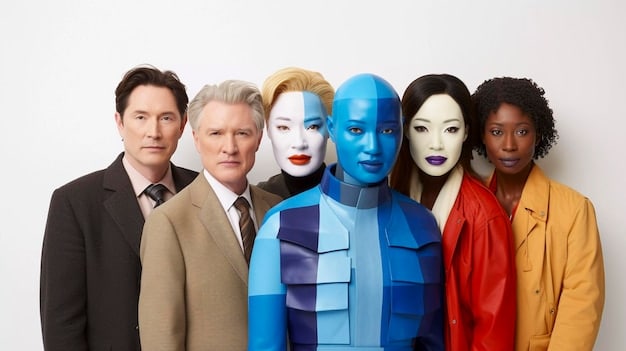Korean Drama Second Lead Syndrome: Why We Love the Underdog (2025)

Korean Drama Second Lead Syndrome (SLS) describes the phenomenon where viewers find themselves rooting for the second lead instead of the main lead in a K-drama, often due to the second lead’s compelling character arc and unrequited love.
Have you ever found yourself inexplicably drawn to the character who *almost* gets the girl in a Korean drama? This is the essence of **Korean Drama Second Lead Syndrome: Why We Root for the Underdog (2025 Analysis)**, a phenomenon that continues to grip our hearts and minds.
Understanding the Allure of Second Lead Syndrome
Second Lead Syndrome (SLS) isn’t just a fleeting feeling; it’s a well-documented emotional response to a specific type of character archetype prevalent in Korean dramas. These characters, often kind, supportive, and deeply in love with the protagonist, frequently face unrequited affections, making them objects of sympathy and fervent support from viewers.
The appeal of the second lead often stems from their perceived authenticity and vulnerability. While the main lead might be portrayed as perfect or destined for greatness, the second lead often embodies relatable flaws and struggles, making them more human and easier to connect with.
The Key Characteristics of a Typical Second Lead
Several recurring traits contribute to the development of Second Lead Syndrome. Understanding these characteristics can help explain why viewers so readily fall for these often-underappreciated characters.
- The Unwavering Supporter: Second leads are often the heroine’s confidantes, offering unwavering support and guidance, even when it means putting her happiness above their own.
- The Tsundere with a Heart of Gold: Some second leads initially appear cold or aloof but gradually reveal a kind and caring nature, often masking their feelings with playful teasing or subtle acts of service.
- The Devoted Protector: Many are willing to sacrifice everything for the female lead, shielding her from harm and providing a constant source of security.
In essence, the second lead represents the “what if” scenario, prompting viewers to imagine a different, potentially more fulfilling, romantic path for the protagonist.

Ultimately, the allure of the second lead boils down to a yearning for genuine connection and the desire to see kindness rewarded. Viewers often believe that the protagonist would be happier with someone who truly understands and appreciates her, rather than someone who is simply destined to be with her.
Why the Underdog Resonates: Psychological Factors
The appeal of the underdog extends beyond just Korean dramas; it’s a deeply ingrained human tendency to empathize with those who are perceived as disadvantaged or overlooked. Several psychological factors contribute to this phenomenon, making Second Lead Syndrome a powerful emotional experience.
Our brains are wired to respond to stories of resilience and perseverance. When we see a character facing adversity with grace and determination, we are naturally drawn to their journey and invested in their success.
The Psychology of Rooting for the Underdog
Understanding the psychological principles at play can shed light on why we often prefer the second lead, even when the narrative clearly favors the main lead.
- Empathy and Identification: Viewers often identify with the second lead’s vulnerability and unrequited love, projecting their own experiences of rejection or unfulfilled desires onto the character.
- The Justice Motive: We have an inherent desire to see things done fairly. When the second lead is consistently overlooked or taken for granted, it triggers a sense of injustice, leading us to root for them to receive the recognition they deserve.
- The Hope for Surprise: Deep down, viewers often hope that the writer will defy expectations and allow the second lead to win the protagonist’s heart, providing a satisfying resolution to the perceived inequity.
The underdog narrative taps into our innate desire for fairness and provides a vicarious sense of triumph when the underdog finally achieves success, even if it’s not in the romantic realm.
In conclusion, the psychological factors behind Second Lead Syndrome are complex and multifaceted, rooted in our innate capacity for empathy, our desire for justice, and our yearning for unconventional narratives.
The Evolution of Second Lead Archetypes in 2025
While the core elements of Second Lead Syndrome remain consistent, the specific archetypes have evolved over time to reflect changing societal values and viewer preferences. In 2025, we see a greater emphasis on complex characters with nuanced motivations and personal growth.
No longer are second leads simply the “nice guys” destined for heartbreak. Modern dramas are exploring more complex and multifaceted characters, giving them more agency and depth.

New Directions in Second Lead Character Development
Contemporary dramas are challenging traditional tropes and introducing innovative approaches to second lead character development.
- The Independent Achiever: Some second leads are fiercely independent characters with their own ambitions and goals, whose romantic desires are secondary to their personal aspirations.
- The Redeemed Antagonist: Formerly villainous characters who undergo significant redemption arcs, earning the audience’s sympathy and respect through acts of selflessness and repentance.
- The Unconventional Love Interest: Characters who defy traditional gender roles or societal expectations, offering a fresh perspective on love and relationships.
These evolved archetypes provide richer and more engaging narratives, offering viewers more reasons to connect with and root for the second lead.
By introducing greater complexity and nuance, modern dramas are reinvigorating the Second Lead Syndrome phenomenon, ensuring its continued relevance and appeal in the ever-evolving landscape of K-dramas.
Examples of Unforgettable Second Leads
Throughout the history of Korean dramas, several second leads have achieved iconic status, capturing the hearts of viewers and solidifying their place in the annals of television history. Their stories continue to be shared and celebrated, fueling the enduring appeal of Second Lead Syndrome.
These characters, through their compelling performances and heartfelt portrayals, have set the standard for what it means to be a truly unforgettable second lead.
Classic Examples of Heartbreakingly Good Second Leads
Let’s explore some of the most beloved and widely recognized second leads in K-drama history:
- Kim Woo-bin in “The Heirs”: His portrayal of Choi Young-do, a misunderstood chaebol heir with a prickly exterior but a soft heart, earned him a devoted following.
- Jung Il-woo in “49 Days”: His portrayal of the motorcycle-riding scheduler with a hidden past resonated with viewers, making him a fan favorite.
- Suzy in “Dream High”: Her understated performance as Go Hye-mi, torn between two talented musicians, sparked intense debates among viewers.
These are just a few examples of the many unforgettable second leads who have left a lasting impression on K-drama audiences.
These characters serve as a testament to the power of compelling storytelling and the enduring appeal of the underdog.
The Impact of SLS on Viewer Engagement and Ratings
Second Lead Syndrome is not just a passive viewing experience; it often fuels active engagement and discussion within online communities. The fervent debates and passionate expressions of support for the second lead can significantly impact viewership ratings and the overall buzz surrounding a drama.
The emotional investment in these characters often translates into increased viewership, as viewers tune in each week to see if their favorite second lead will finally get a chance at love.
How Second Lead Syndrome Drives Online Conversations
The debates surrounding Second Lead Syndrome often extend beyond mere personal preferences, delving into deeper discussions about love, relationships, and societal expectations.
- Fan Theories and Speculation: Viewers actively participate in online forums, sharing their theories and predictions about the potential romantic outcomes of the drama.
- Character Analysis and Debate: In-depth discussions dissect the motivations and actions of both the main lead and the second lead, often challenging the narrative’s established romantic trajectory.
- Fanfiction and Creative Content: Fans create their own stories and artwork featuring the second lead, exploring alternative scenarios and giving the character the happy ending they deserve.
This active engagement amplifies the impact of Second Lead Syndrome, transforming it from a simple emotional response into a catalyst for community building and creative expression.
In conclusion, Second Lead Syndrome plays a significant role in shaping viewer engagement, driving online conversations, and influencing the overall reception and success of a Korean drama.
Predicting Second Lead Syndrome Trends in 2025 and Beyond
As the K-drama landscape continues to evolve, it’s important to anticipate the future trends of Second Lead Syndrome and how it will continue to captivate audiences in the years to come. In 2025, we can expect to see even greater experimentation with character archetypes and narrative structures, pushing the boundaries of the traditional romantic framework.
The future of SLS lies in embracing complexity and challenging conventional notions of love and happiness.
Anticipated Shifts in Second Lead Characterization
Here are some potential trends that may shape the future of Second Lead Syndrome:
- Gender-Swapped Second Leads: Exploring the dynamic of a male protagonist vying for the attention of a female lead, challenging traditional gender roles and offering a fresh perspective on unrequited love.
- Second Leads with Open Endings: Instead of a definitive rejection, the second lead’s story concludes with ambiguity, leaving the audience to imagine their own happy ending and fostering a sense of hope and possibility.
- Second Leads Who Find Happiness Elsewhere: The narrative focuses on the second lead discovering a different path to happiness, proving that romantic love is not the only measure of success.
These future trends promise to keep Second Lead Syndrome relevant and engaging, ensuring its continued presence in the world of K-dramas.
By embracing innovation and challenging traditional tropes, the future of Second Lead Syndrome looks bright, promising to deliver even more complex and emotionally resonant stories in the years to come.
| Key Aspect | Brief Description |
|---|---|
| 💔 Unrequited Love | The second lead’s unreciprocated feelings tug at heartstrings. |
| 💪 Underdog Appeal | Viewers often empathize and root for the overlooked character. |
| ✨ Character Growth | Second leads may experience profound personal transformation. |
| 🎭 Evolving Archetypes | Modern second leads challenge traditional stereotypes. |
Frequently Asked Questions
▼
Second Lead Syndrome describes viewers’ preference for the second lead character over the main lead in Korean dramas, usually due to empathy, relatability, or a sense of injustice.
▼
People tend to prefer second leads because they often embody vulnerability, kindness, or a sense of missed opportunity, making them more relatable or sympathetic.
▼
Yes, Second Lead Syndrome has evolved. Modern second leads often have more complex backstories, independent goals, and active redemption arcs, deviating from the traditional “nice guy” trope.
▼
Focusing on the entire narrative, rather than just the romantic pairings, can help mitigate Second Lead Syndrome. Appreciate the complexities and merits of both leads.
▼
Second Lead Syndrome can enhance a K-drama’s popularity by generating online buzz, fan theories, and passionate debate, ultimately increasing viewership and engagement.
Conclusion
Ultimately, **Korean Drama Second Lead Syndrome: Why We Root for the Underdog (2025 Analysis)** is a testament to the power of storytelling and the human desire for connection and justice. As K-dramas evolve, so too will the nuances of SLS, continuing to captivate audiences with tales of unrequited love and the enduring appeal of the underdog.





